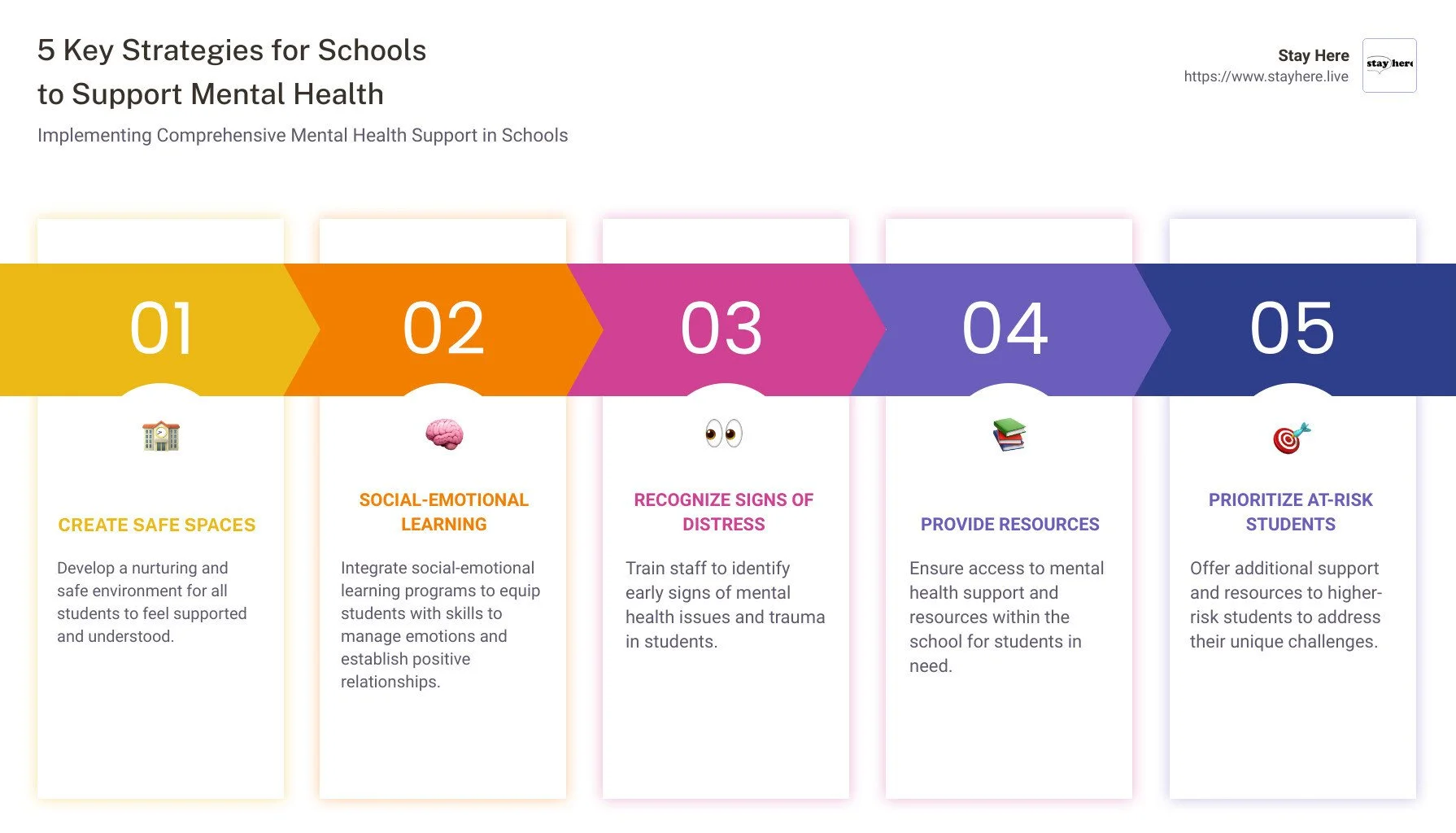A Comprehensive Guide to School Support for Mental Health
Schools are much more than spaces for academic growth; they're vital platforms for nurturing students' mental health. Is your school equipped to support the emotional well-being of its students effectively?
Today, a staggering one in five children grapples with a diagnosable mental, emotional, or behavioral disorder. Yet, many do not receive the help they need. With such a robust link between students' mental health and their academic success, it becomes crucial to urge schools to play a more active role in fostering a mentally healthy environment.
Here at Stay Here, we understand the complexities of this pressing issue. In this comprehensive guide, we aim to provide you with effective strategies on how schools can be instrumental in supporting mental health. We will delve into various aspects including the creation of safe, caring spaces, the importance of implementing social-emotional learning programs, recognizing signs of mental health concerns, and many more.
Understanding the Mental Health Crisis in Schools
Mental health has become an increasingly critical issue in our schools, exacerbated further by the ongoing impacts of the COVID-19 pandemic. In this context, the role of schools in supporting students' mental health has never been more vital.
The U.S. Surgeon General's Health Advisory on Student Mental Health
The gravity of this situation led the U.S. Surgeon General, Vivek H. Murthy, M.D., M.B.A., to release a health advisory addressing the student mental health crisis. His words were stark, emphasizing that mental health challenges in children, adolescents, and young adults are real, widespread, and most importantly, preventable, and treatable. He called on schools and communities to act, warning against the tragedy of exchanging one public health crisis (COVID-19) for another (mental health).
The Impact of Mental Health on Academic Success
Mental health is not just about personal well-being; it deeply impacts academic success as well. Stress, anxiety, and other mental health issues can lead to lower grades, dropout rates, and other negative outcomes in the academic sphere. Therefore, supporting student mental health is not just about compassion; it's about ensuring the overall success and future of our students.
The Role of Schools in Addressing Mental Health Issues
So, how can schools support mental health? Schools are unique spaces where students spend a significant portion of their day, making them a vital touchpoint for early intervention. They can play a key role in establishing safe, caring spaces where students feel comfortable reaching out about their mental health issues. They can also provide resources and support, such as academic counseling, brief interventions to address behavior problems, and linkages to other necessary services.
However, this requires a proactive approach from schools. As the Surgeon General's advisory suggests, a school's culture should be strengthened to be positive, safe, and affirming. This involves developing and enforcing anti-bullying policies, using inclusive language, implementing structural changes beneficial to students' mental health, and promoting mental health literacy among staff and students.
As we at Stay Here know, it's a daunting task but one that is critical to our students' well-being and future. In the next sections, we'll delve deeper into the strategies that schools can adopt to effectively support their students' mental health.
Strategies for Schools to Support Student Mental Health
Supporting the mental health of students is a complex endeavor requiring a multi-pronged approach. Each school is unique, and so are the students within them. However, there are some broad strategies that have been shown to be beneficial across different contexts. Here are some ways on how schools can support mental health.
Creating Positive and Safe Environments in Schools
A school's culture and environment play a crucial role in student mental health. Creating a "positive, safe, and affirming" environment makes students feel comfortable and valued (Navigate360). This includes developing and enforcing anti-bullying policies, training students and staff to prevent harm, and using inclusive language and behavior. Schools can also consider structural changes, like later starts to the school day, which has been shown to benefit students' mental health.
Implementing Social-Emotional Learning Programs
Social-Emotional Learning (SEL) programs are beneficial for students' mental health development. These programs don't have to significantly alter lesson plans or schedules, as they can be designed to blend seamlessly with a school's existing structure. SEL programs promote understanding and management of emotions, set and achieve positive goals, feel and show empathy for others, establish and maintain positive relationships, and make responsible decisions.
Recognizing Signs of Trauma and Behavior Changes
Educators are often the first to notice changes in a student’s behavior. Recognizing signs of trauma and behavior changes and taking swift action can make a significant difference. The quicker teachers connect these students with appropriate mental health services, the better the outcome will be. Training staff to identify these signs is a crucial part of a school's mental health strategy.
Providing Mental Health Support and Resources
Schools should be prepared to help students receive proper mental health care as soon as needed. Linking up with providers like the Project AWARE program can help fund school-based practices such as mental health screening, early intervention, prevention, and treatment. Schools can also consider implementing mental health literacy training for teachers and staff, as we at Stay Here recommend.
Prioritizing Higher-Risk Students
Certain students may be at a higher risk of experiencing mental health issues, and schools should prioritize providing support to these students. This could include students experiencing homelessness, those in the foster care system, students from low-income families, and those with a history of trauma or substance abuse. Identifying these students and ensuring they have access to the necessary resources is crucial.
In conclusion, schools play a vital role in supporting student mental health. By creating safe environments, implementing SEL programs, recognizing signs of trauma, providing mental health resources, and prioritizing higher-risk students, schools can make a significant impact in addressing the mental health crisis among youth.
The Role of Teachers and Staff in Supporting Student Mental Health
The responsibility of promoting mental health in schools extends beyond the boundaries of just the students. Teachers and staff members, who interact directly with the students daily, play a pivotal role in creating a supportive environment. In this section, we will discuss how increasing mental health literacy among school staff, training teachers to recognize signs of mental health concerns, and supporting the mental health of staff members themselves can fortify the efforts of schools in supporting mental health.
Increasing Mental Health Literacy Among School Staff
A critical step towards creating a supportive environment in schools is increasing mental health literacy among school staff. Mental health literacy includes understanding the signs of mental health issues and knowing how to respond effectively. In practice, this can involve regular training sessions that equip teachers and staff with the knowledge to identify and respond to mental health concerns in students.
At Stay Here, we believe in the power of education. Our Stay Here Guides are designed to help school staff understand the complexities of mental health issues and provide practical guidance on how to help students navigate these challenges.
Training Teachers to Recognize Signs of Mental Health Concerns
Teachers are in a unique position to spot the signs of mental health issues in students due to their daily interactions. Therefore, it's crucial that they receive training on how to recognize these signs and respond effectively. As SAMHSA suggests, teachers should be trained to recognize signs of mental health concerns and understand how to respond, ensuring that students receive the help they need.
Such training can be part of a wider strategy to integrate mental health education into the school curriculum, promoting understanding and empathy among students and reducing prejudice and discrimination associated with mental health conditions.
The Importance of Mental Health Support for Staff Members
Supporting the mental health of staff members is equally important. A healthy and happy staff is better equipped to help students with their mental health. Schools can take steps to ensure staff wellbeing, such as establishing realistic workloads, maintaining stable staff-to-student ratios, providing competitive pay, and benefits, and regularly assessing staff mental health.
At Stay Here, we understand the importance of mental health for everyone, not just our students. Our ACT Suicide Prevention Training is designed not only for students but also for educators. The training provides practical tools to deal with mental health crises, whether it's for oneself or someone else.
In conclusion, the role of teachers and staff is pivotal in shaping the mental health support system in schools. By increasing mental health literacy, training staff to recognize signs of mental health issues, and supporting the mental health of staff members themselves, schools can create a comprehensive support system for student mental health. These efforts, combined with the resources and initiatives provided by organizations like Stay Here, can significantly contribute to addressing the mental health crisis in schools.
Collaborating with Community Partners for Enhanced Mental Health Support
A crucial aspect of how schools can support mental health is through community collaboration. Schools are an essential part of the community, and working with local organizations and resources can provide a more comprehensive support network for students.
Connecting Students with Behavioral Health Coverage
One way schools can help is by assisting students and their families in enrolling with Medicaid and CHIP, both of which offer access to behavioral health services. The Connecting Kids to Coverage National Campaign is a valuable resource that can guide schools in these enrollment activities and mental health services.
Partnering with Community Organizations for Mental Health Services
Partnerships with community organizations can significantly enhance the mental health support schools can provide. At Stay Here, we've seen firsthand how these collaborations can lead to positive outcomes. For example, our partnership with THE HOPELINE, a live chat line that has been supporting individuals for 20 years, provides an immediate resource for students who are struggling.
We also collaborate with a collective group of nonprofits, companies, and individuals known as The 40. This partnership aims to change statistics and save lives, with a documented impact of helping save over 12,000 lives a year.
The Benefits of Collaboration in Improving Student Success
Collaborating with community partners not only enhances mental health support but also contributes to overall student success. According to a study cited on Youth.gov, schools that collaborate with community partners have found significant improvements in schoolwide truancy and discipline rates, increased high school graduation rates, and a more positive school environment in general.
In conclusion, community collaboration plays a vital role in how schools can support mental health. By connecting students with behavioral health coverage, partnering with community organizations, and realizing the benefits of these collaborations, schools can provide a more robust and effective mental health support system for their students. At Stay Here, we are committed to continuing our partnerships to support schools in their mental health initiatives.
California's Approach to School-Based Mental Health Support
As we delve deeper into understanding how schools can support mental health, highlight the initiatives taken by California, a state grappling with a high number of Behavioral Health Professional Shortage Areas (BHPSAs). These shortages disproportionately affect marginalized communities and those living in rural parts of the state.
The Mental Health Support Initiative in California
To address the amplified need for mental health support among students and staff, California has launched the Mental Health Support Initiative. The initiative aims to foster a school environment where all students are valued, respected, and have their voices heard. The fundamental idea is to create a nurturing and safe school campus, a haven for students to thrive despite any personal challenges they may be facing.
Resources Offered by the California Department of Education
The California Department of Education (CDE) offers a variety of resources to bolster mental health support in schools. These resources include the Youth Mental Health First Aid (YMHFA) training, monthly webinars on youth suicide prevention, and the Resilient Practices for Educators webinar series.
The YMHFA training is a 6.5-hour interactive program designed for adults who interact with students aged six to eighteen. It can be delivered virtually, in-person, or in a hybrid setting. The monthly webinars aim to strengthen prevention, intervention, and postvention practices in schools. Lastly, the Resilient Practices for Educators webinar—developed in partnership with Kaiser Permanente and the Alliance for a Healthier Generation—emphasizes staff wellness, acknowledging that the well-being of school communities significantly impacts students' mental health.
Addressing the Shortage of Licensed Health Professionals in Schools
Recognizing the need for more mental health professionals, the 2022–23 California State Budget package includes key investments to address the shortage. The budget allocates $184 million for teacher and school counselor residency programs and extends an existing $350 million residency program to school counselors. Moreover, the Golden State Teacher Grant Program offers grants up to $20,000 to individuals pursuing their Pupil Personnel Services credential to serve as school counselors.
These investments will ensure an increase in mental health professionals in schools, providing necessary support to our students. At Stay Here, we applaud these efforts and continue to advocate for more investment and focus on mental health in schools, contributing our resources and expertise where we can. We are always here to help.
The Role of Stay Here in Supporting School Mental Health Initiatives
Our mission at Stay Here is not just about creating awareness, but about providing practical solutions for mental health challenges. We aim to equip schools, communities, and individuals with tools that foster mental health and prevent suicide.
Stay Here's Vision for a Suicide-Free Generation
We envision a world where Gen Z is free from suicide. We believe in a future where every student understands that they are loved, they have a purpose, and their story isn't over. To realize this vision, we are committed to providing resources that increase mental health literacy, foster resilience, and create an environment of understanding and empathy.
Jacob Coyne, one of our topic experts, emphasizes the importance of every individual's commitment to this vision, "The world is better with you in it, and we are here to help you stay."
Suicide Prevention Training and Awareness Programs for Schools
One of the essential ways we contribute to how schools can support mental health is through our ACT Suicide Prevention Training. This training is designed to equip school staff, students, and the wider community with the necessary knowledge and skills to identify signs of mental distress and respond effectively.
Our mission is to train 1 million individuals, 10,000 schools, and 10,000 churches, fostering a suicide-free generation. We believe that through collective efforts, we can fight to end suicide in our generation. As Jacob Coyne affirms, "Will you be one of the one million who fight to end suicide in our generation?"
Stay Here also offers speaking engagements where we equip audiences with the tools and knowledge needed to tackle discussions surrounding mental health and suicide prevention. Our compelling message has inspired many individuals to make the pledge to keep living and to seek the proper help towards wholeness.
The Impact of Stay Here's Mental Health Clothing Line on Gen Z
Beyond training and awareness programs, we also have a unique approach to promoting mental health: our clothing line. Each piece of Stay Here merchandise carries a message of hope and resilience, sparking meaningful conversations about mental health.
We believe that the simple act of wearing a Stay Here item can serve as a beacon of support for those struggling with mental health issues. Plus, every purchase directly supports our mission to prevent suicide and heal broken hearts, as 100% of the proceeds go towards our initiatives.
In conclusion, schools play a key role in supporting mental health, but they don't have to do it alone. At Stay Here, we are committed to partnering with schools, providing resources, training, and support needed to create a mentally healthy environment for students. We're here to help you stay.
Conclusion: The Path Forward for Schools in Supporting Mental Health
Addressing the mental health crisis in schools is an urgent and critical task. As schools are increasingly recognized as essential nodes in the mental health support network, the question of 'how can schools support mental health' continues to gain significance.
As we've explored, this support can take various forms, from creating positive and safe environments to implementing social-emotional learning programs, recognizing signs of trauma, and providing relevant resources. But perhaps what stands out the most is the need for a collaborative approach. This means engaging with community partners, staff, teachers, and students themselves to create a comprehensive, integrated, and responsive mental health support system.
Our expert, Jacob Coyne, emphasizes the importance of increasing mental health literacy among school staff. The more aware they are, the better equipped they are to notice signs and symptoms early. It's equally vital to ensure that staff members themselves feel supported, as their wellbeing directly impacts their ability to support students.
California offers a promising model with their Mental Health Support Initiative, which focuses on fostering school communities where all students feel supported, respected, and valued. They offer a range of resources and training to support mental health, highlighting the importance of state-level commitment in tackling this issue.
At Stay Here, we fully support these efforts and are committed to doing our part in the battle against the mental health crisis. With our vision for a suicide-free generation, we offer suicide prevention training and awareness programs for schools. Our resources are designed to equip both students and staff with the tools and knowledge needed to tackle mental health discussions and provide support.
Stay Here also offers avenues of support for those in need, providing help through coaching, speaking at assemblies, and starting programs in schools.
In conclusion, the path forward for schools in supporting mental health involves collaboration, education, and proactive intervention. Schools, together with organizations like Stay Here, are taking significant steps to ensure our young people have the mental health support they need to thrive.
For more information on our initiatives, how you can get involved, or how we can support your school, visit us at Stay Here.




